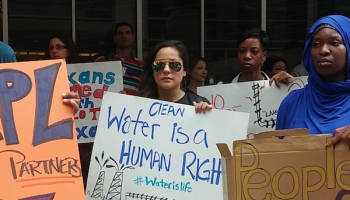Fewer PFAS “forever chemicals” in the country’s drinking water will soon be a reality, thanks to a new rule by the Environmental Protection Agency (EPA).
On April 10, the EPA finalized new enforceable drinking water protections to provide safer drinking water for communities by establishing strong limits on six widely detected PFAS, including PFOA, PFOS, PFNA, PFHxS, HFPO-DA (GenX), and PFBS. The standards will save thousands of lives and prevent PFAS-related illnesses across the country.
In the United States, PFAS have impacted the drinking water of an estimated 200 million people. Nearly every American has PFAS in their blood.
PFAS are a class of thousands of toxic chemicals found throughout the Great Lakes watersheds. In Michigan, 192 drinking water systems and at least 11 military sites across the state are contaminated with PFAS. In Wisconsin, 24 drinking water systems and seven military sites across the state are contaminated with PFAS. In Ohio, 145 drinking water systems and nine military sites across the state are contaminated.
The EPA's new drinking water standards will mark the first time a new chemical has been added under the Safe Drinking Water Act since 1996. The proposed drinking water standards are:
- 4 parts per trillion for PFOA
- 4 parts per trillion for PFOS
- 10 parts per trillion for PFNA
- 10 parts per trillion for HFPO-DA (commonly known as Gen X)
- 1 parts per trillion for a hazard mixture of four PFAS chemicals: PFNA, PFHxS, PFBS, and HFPO-DA
The Ecology Center, our partners, and impacted community leaders through the Great Lakes PFAS Action Network (GLPAN) work to prevent PFAS pollution and clean up existing contamination. In support of the new rule change, GLPAN submitted comments directly to the EPA and authored a letter with nearly 200 organizations and individual signees from across the Great Lakes to submit to the White House. GLPAN community leaders met with congresspeople and the EPA in Washington, D.C., to encourage the EPA to finalize the rules.
While Michigan and some Great Lakes states already have drinking water standards for PFAS many states do not. Further, the EPA's proposed rules are stronger than Michigan’s existing state standards and will create better protections from harmful PFAS exposure.
PFAS exposure is linked to severe health issues, including increased rates of cancer, developmental and reproductive harm, and other diseases. Many GLPAN PFAS-impacted community leaders have personally experienced health problems from living in PFAS-affected communities.
The Ecology Center applauds these new protections, and will continue to work with our partners and PFAS-impacted community members to push for PFAS-free drinking water across the Great Lakes region.


